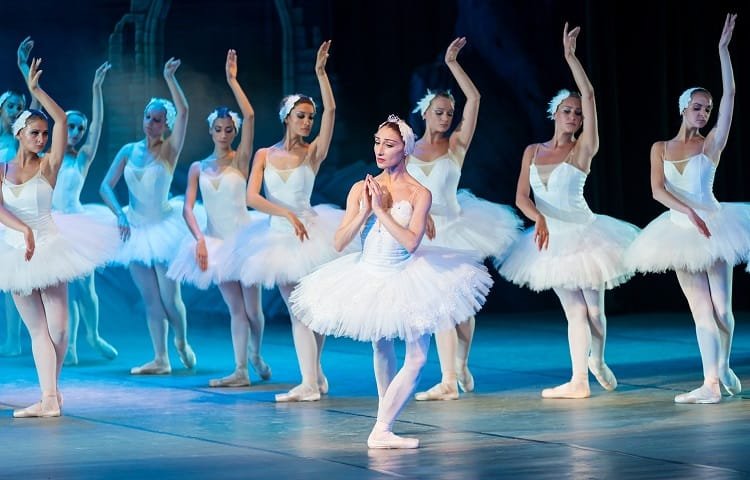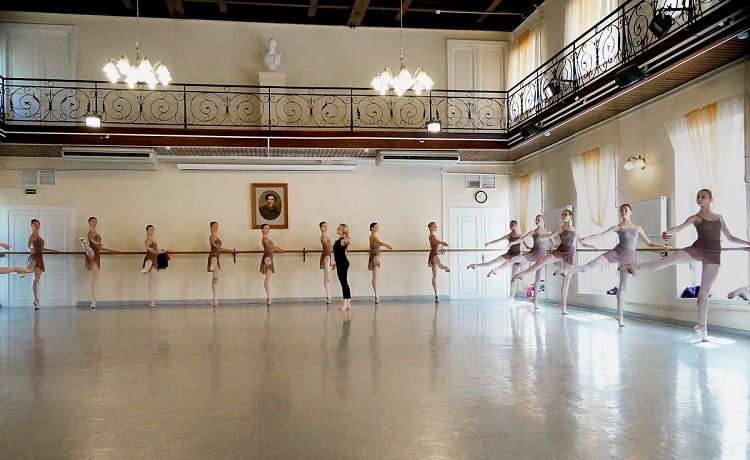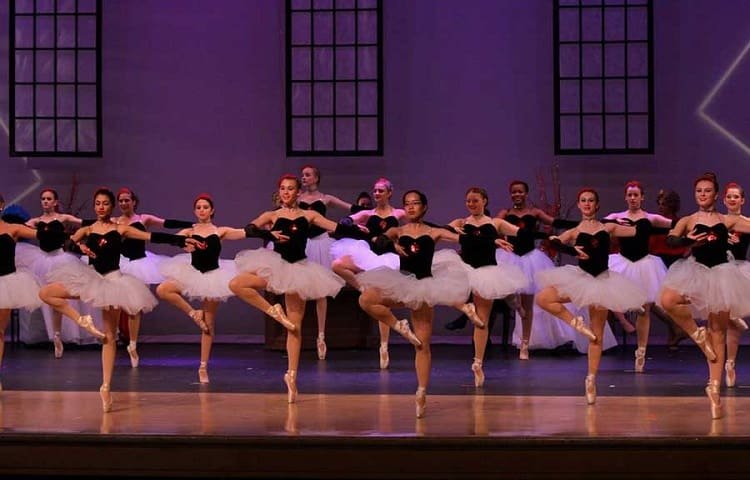 Ballet is ballet, right?
Ballet is ballet, right?
Not even close.
There are numerous different types of ballet. Dances in each style can differ considerably.
Whether you simply want to know more about this art form or you are interested in becoming a dancer yourself or getting your child into it, you need to understand the main types.
You need to know how they differ, how they are similar and how they relate to each other.
Only then can you choose the best ballet style for you or your future ballerina.
We’ll begin with a brief overview and history of ballet. This is important in understanding how the different types relate to each other.
Table of Contents
Types Of Ballet: Overview And History

Ballet is one of the most classical and artistic dances in the world. It has a centuries-long history.
It first emerged during the Italian Renaissance in the 15th century. France and Russia later developed the techniques further. They made ballet a concert dance.
French ballet dancers had the most effect on improving the ballet dance. They extended its reach significantly.
Ballet dance became famous all over the world in the 20th century. Classic ballet companies inserted their unique culture into the dance.
Ballet dances hailed from numerous countries throughout the years. But ballet’s basic terminology is based on French vocabulary.
Even the word “ballet” itself is a French word. It’s derived from the Italian word “Balletto,” which means “to dance.”
Types Of Ballet Dance
Different types of ballets emerged in various regions and timeframes. Some of them are combinations of others. Others are entirely unique in terms of techniques.
Music is a fundamental element in every type of ballet dance. Classical ballet is performed to classical music, for example.
The differences between types of ballet dance go far beyond just the dance moves and ballet variations. Even the ballet dancers’ clothing is different. In classical ballet, you see elaborate, traditional costumes. In modern styles, like neoclassical ballet dance, you see modern outfits.
The following are the most popular types of ballet dance.
Classical Ballet

As the name implies, classical ballet is one of the oldest ballet dances. Based on traditional techniques and vocabulary, classical ballet has unique techniques and language.
Classical ballet had its peak in the 19th century in France and Russia. Ballet dancers in France, Italy, England, and Russia each developed their own unique dance techniques.
This resulted in various subcategories of classical ballet, each with distinct training methods. Most were developed by famous ballet dancers and are named after their creators. Vaganova, Cecchetti, Bournonville, and Balanchine are some of them.
There is one method of classical ballet that is recognized internationally: the Royal Academy of Dance method. It is a combination of various forms: English, Russian, French, and Italian are all mixed together.
It was developed to create a unique classical style for the organization. Today, the method is known as the English style of ballet.
Classical ballet isn’t just a style from decades past. Ballet dancers still perform some of the classical ballets in theatres. The most popular ones are:
- Swan Lake
- The Sleeping Beauty
- The Nutcracker
Anna Pavlova (19th century), Dame Margot Fonteyn (20th century), and Rudolf Nureyev (20th century) are three of the most famous classical ballet dancers.
The training method in classical ballet includes multiple steps. It is important that ballet students learn the terminology, with the correct pronunciation and meaning.
Of course they also need to learn the precise body form and movement, in addition to the terminology.
A classical ballet dancer needs to work hard on body strength and flexibility. Training focuses on the feet, legs, and the core muscles. They need to be strong for the dancer to be able to perform the movements correctly and professionally.
Neoclassical Ballet

This form of ballet dance is derived from classical ballet. The dance involves abstract methods and movement. Neoclassical ballet has no specific costume, scenery, and plot.
The music for neoclassical ballet is often a piece of neoclassic music (imagine that). Stravinsky and Roussel’s music are common in neoclassical ballets.
Neoclassical ballet dance is often known for its informality. Nothing is formal or framed in this dance. In other words, there are endless possibilities in this style.
Neoclassical ballet dancers often combine multiple techniques and choreography in their dances. The combination can create something entirely unique.
Neoclassical ballet dancers need to work hard on their bodies. The style includes strong moves that require exceptional fitness. Trainers focus heavily on athleticism. This style carries increased physical risks, too.
The history of neoclassical ballet goes back to the 1920s. The style evolved in the 20th century, through the work of famous ballet dancers like George Balanchine, Frederick Ashton, and Kenneth MacMillan.
George Balanchine is often known as the choreographer who birthed, and evolved, the neoclassical ballet style. He worked hard on the style and movements. Balanchine wanted to remove the limits of the classical style to create more modern techniques.
He performed the Apollon Musegete choreographed in 1928 for the Ballets Russes as his first neoclassical dance. He used a piece of music from Stravinsky. Other famous neoclassical works from Balanchine are:
- Apollo
- The Prodigal Son
- Serenade
- Concerto Barocco
- Symphony in C
- Agon
- Jewels
Contemporary Ballet

The other style that was derived from classical ballet is the contemporary style. It takes some elements from the classical style and combines them with modern techniques.
In most contemporary ballet dances, you see a combination of classical style with jazz dance. Dance that focus on athleticism are common in contemporary ballet.
There are more prominent and swifter tempos in contemporary ballet. You also see complex plots, scene designs, and dance moves in contemporary performance.
Contemporary ballet dancers often perform barefoot. You see lots of acting in this dance. The music is usually orchestral. But sometimes the artists choose vocal music, too.
This type of ballet dance has many similarities to neoclassical and contemporary dance. All of them were born during the early 20th century. Lots of floor work and turn-in of the legs is typical in all of these dances.
The difference between contemporary ballet and contemporary dance is the essential role of ballet techniques in contemporary ballet.
George Balanchine is, again, considered a pioneer in this type of ballet dance. But many professional dancers call Twyla Tharp the inventor.
Two of the first famous contemporary ballets were “Push Comes To Shove” and “In The Upper Room.”
Some of the current leading choreographers in contemporary ballet are:
- Alonzo King
- Matthew Bourne
- Nacho Duato
- William Forsythe
- Jiří Kylián
Romantic Ballet

Romantic ballet has many of the same characteristics as the traditional style. But it has additional elements that create drama. The style was born in the 19th century (the romantic era, naturally). The emergence of the pointe work played a critical role.
Storytelling and drama are two of the crucial elements in romantic ballet. Female dancers play the most important role. The ultimate goal in romantic ballet is to demonstrate softness and an elegant atmosphere. Longer, flowy tutus are dominant.
As the name implies, romantic ballet focuses on emotions. Performers try to mimic movements that display an aesthetic experience.
The first plots in the early romantic ballets were about imaginary women. The main characters were ghosts and ferries who enslave mortal men’s souls.
Romantic ballets are about the conflict between the dark and bright sides of the world. The primary elements in plots are the good and evil in our hearts.
Two of the most famous romantic ballets are “Coppélia” and “La Sylphide.” There were many female ballet dancers who became famous during the romantic era. Some of them are:
- Marie Taglioni
- Fanny Elssler
- Jules Perrot
Ballet Styles Based On Training Methods
Some ballet styles are classified based on the training methods. These styles are named after their innovator instructors. The following are some of the most famous ones.
Vaganova Ballet

Agrippina Vaganova created the Vaganova ballet method in the 20th century. The style is based on Russian ballet. Vaganova combined the basics with elements from French, Italian, and Romantic ballets.
Vaganova ballet dancers train in a mixture of core elements from different styles. This includes classic elements from the French ballet, athleticism from the Italian, and romantic elements from the romantic style.
The Russian innovator of this method published a book about it in 1948. Basic Principles of Russian Classical Dance describes the training process in detail. It focuses on three skills to train dancers: flexibility, strength, and endurance.
Vaganova ballet trains the whole body. Trainers focus on the strength, flexibility, and endurance of the dancers’ arms and legs. This helps the dancers achieve better harmony and expression in their bodies.
French Ballet

French ballet dancers had a significant effect on extending the art form. Their unique style was the basis for all of the other types of ballet. There is a specific training method for dancers who want to learn French ballet.
The history of the French ballet goes back to the 17th century when Louis XIV founded a dance school named Académie Royale de Danse. This academy became the birthplace of the French ballet.
Rudolf Nureyev was responsible for developing a standard for teaching French ballet. He was one of the most famous ballet dancers of the 20th century. He renewed the French dance school in the 1980s and tried to codify the techniques in this style.
There are some differences between French ballet and other styles. The épaulement and port de bras moves have specific techniques in this style, for example. Dancers perform them in a more rounded shape than in the Russian style.
French ballet is focused on fluidity in movement more than anything else. Clean, elegant lines are other distinguishing features of this style.
French ballet dancers are obsessed with precision in their technical movements. Professional dancers in this style have very swift footwork.
Cecchetti Ballet Method

Also known as the Italian ballet, the Cecchetti ballet method is obsessed with anatomy. Developed by Enrico Cecchetti in the 19th century, Italian ballet is strongly related to classical ballet.
Cecchetti dancers need to do a lot of work and training. The instructors try to instill the fundamentals of movements into the students. That way they perform movements instinctually and don’t simply imitate the instructors.
Cecchetti’s ballet focuses on all parts of the body. A student needs lots of training to learn the required balance, elevations, strength, and the unique Italian ballet pose.
Harmony between all parts of the body is vital in the Cecchetti ballet. A professional dancer moves all of the body parts together to create beautiful lines. Eight port de bras is a core spec in Italian ballet, too.
Ballet Hierarchy
Ballet companies are schools or institutes that manage ballet tours. They find, train, hire, and pay talented performers. There is a hierarchy in each ballet company. It demonstrates the roles and responsibilities.
The traditional system of ballet dancer ranking categorized female and male dancers separately. It faced some criticism for defining different names like Ballerina and Danseur. Today, ballet companies have sex-neutral rankings. But they still emphasize the hierarchy.
The current ballet hierarchy in most ballet companies worldwide is (from top to bottom, in terms of the skills and responsibilities):
- Principal
- Soloist
- Demi-soloist
- Corps de ballet
- Apprentice
Types Of Ballet: Conclusion
The different types of ballet dances all have similarities, because they are all derived from each other. But each one focuses on different aspects of the art. Most of today’s ballet dances inherited the core aspects of classical French ballet.
Some of the newer ballet styles like neoclassical or contemporary ballet combine modern art elements with the dance. They demonstrate a more dynamic art that is still just as attractive as classical ballet. Some would say it is more beautiful, but as always, it is a matter of personal taste.
If you want to become a professional ballet dancer in any style, you will need professional instruction in a dance studio. But you can also get additional practice in at home, especially if you get a ballet barre that is portable. If you have one, you can start with these simple ballet barre workout routines.
Leave a Reply